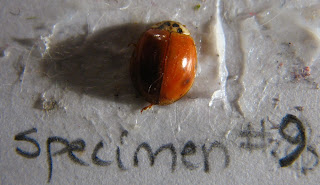I
was recently sitting in a chair with a cat in my lap, staring at a passage in a
book without actually reading it, when an Asian Beetle suddenly landed on my
hand. My first instinct was to flick it away, which I did, but a second one
immediately took its place (Seeing as how I was sitting next to a fluorescent
lamp and the stupid bugs infiltrate old homes like mine in droves). I was about
to flick that one away as well, but for some reason, I arbitrarily decided to
watch it and see what it did. I’m a bug fanatic, so it was interesting,
watching the way the little club antenna poke around at the ground and its
jointed legs moving in perfect synchronization. I watched it like this,
enthralled, while it wandered across my hand, and after about a minute, it
decided to bite me. I promptly flicked the little ingrate across the room. I
got an idea out of it, though.
 Why
are ladybug spots always different? Granted, the species currently crawling
around my house in shiny, sickly-orange mobs is not that of true ladybugs, but
rather of the invasive Asian Beetle breed (Harmonia axyridis) that have been spreading
across the U.S since 1992. Unfortunately for me, it’s currently late November,
so my wildlife sampling scope is somewhat limited, and I had to make do.
Why
are ladybug spots always different? Granted, the species currently crawling
around my house in shiny, sickly-orange mobs is not that of true ladybugs, but
rather of the invasive Asian Beetle breed (Harmonia axyridis) that have been spreading
across the U.S since 1992. Unfortunately for me, it’s currently late November,
so my wildlife sampling scope is somewhat limited, and I had to make do.
My
first step was to collect some bugs:
 After
that, I had to photograph them. Unfortunately, my camera has only a rudimentary
zoom system, so I had to create an elaborate jerry-rigged setup to hold the
bugs steady whilst getting close enough to photograph them. Lighting was
interesting—I had to use my desk lamp as a flashlight, and the shells of the
ladybugs gave so much glare that it was impossible to photograph both sides at
once. As a result, there are two pictures of each specimen.
After
that, I had to photograph them. Unfortunately, my camera has only a rudimentary
zoom system, so I had to create an elaborate jerry-rigged setup to hold the
bugs steady whilst getting close enough to photograph them. Lighting was
interesting—I had to use my desk lamp as a flashlight, and the shells of the
ladybugs gave so much glare that it was impossible to photograph both sides at
once. As a result, there are two pictures of each specimen.
When
I finally got all of my photographs, I uploaded them to my computer and went
through them on powerpoint. What I found was this: Out of ten specimens, there
wasn’t a single pair between them. Two had the same number of spots, but the
size and distribution was different. Some of them, of course, had been dead
when I found them, and so their carapaces were too faded to count spots, but
barring those, there were no patterns.
So
the question remains: why are ladybug markings different?
The
internet has no clues for me. I was able to find why they have spots, period.
It is surmised that the spots, coupled with the bright orange/red carapace,
works as a warning system to predators, alerting them to the fact that ladybugs
are bad-tasting and slightly poisonous. There are many other species that work
this way: blue-ringed octopi, green-arrow frogs, hornets, and monarch
butterflies. The method discourages predators from eating anything
brightly-colored after their initial encounter with a poisonous individual,
leaving everyone else in peace. Some species, like the viceroy butterflies that
have developed patterns very similar to the monarchs, piggyback on this concept
by imitating species that are actually poisonous.
As
to ladybugs, a possible theory as to why their spots are different is
identification, though that would not explain why other beetles, which appear
in every respects identical to the human eye, are capable of telling one
another apart regardless. Another theory (which, in my opinion, seems more
likely), is that the patterns are simply random. If I were to collect enough
ladybugs, I might, in time, find two that are exactly alike. In short, I do not
know the answer to my original question, though I learned a few things in the
finding of this conclusion. If any of my readers do know the answer, I implore
you to post the answer below in the comments section for posterity.
Thank you for reading, and happy Thanksgiving.
S.R. Koch.
Resources:
With special thanks to Eric Sloane’s America, Poems of Byron Keats and Shelly, H.W Janson’s History of Art, The Webster’s Dictionary, The Poetical Works of Browning, and Ken Follett’s The Pillars of the Earth, for propping
up my photography background during my haphazard picture shoot.
...And here's the photos I took of my Asian Beetle sampling (note: specimens six and three were old and faded):




















